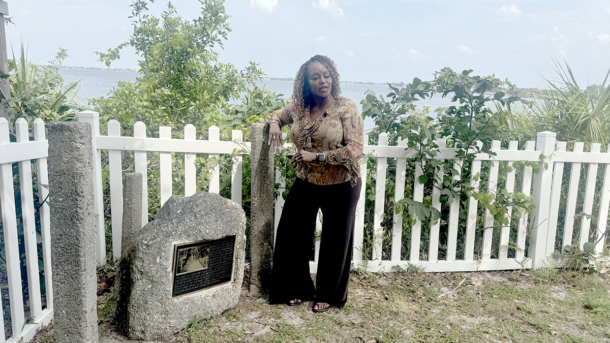MELBOURNE — Three emancipated Black men—Peter Wright, Wright Brothers, and Bailum Allen—laid the foundations of Melbourne at Crane Creek after the Civil War. Historian Dr. Teri Jones and filmmaker Mark Spate Smith are working to bring their overlooked contributions to light through research, education, and film.
After the war, the U.S. government gave land to settlers willing to inhabit and cultivate it. Crane Creek remained difficult to settle, as much of it was swamp, and interactions with the Seminole Indians were complex due to their history with outsiders. The government encouraged settlement through land grants, leading a few determined individuals to take the chance.
“It was people of color or brown-skinned were able to integrate with the Seminoles a lot easier and work together,” said Jones.
Despite these challenges, some settlers built a new life. Jones explains that strong relationships with the Seminoles helped them survive. In 1867, Peter Wright claimed 160 acres along Crane Creek. In 1870, Wright Brothers and Bailum Allen joined him, clearing land, building homes, and planting citrus groves, forming the foundation of Melbourne.
“It wasn’t until 1877, when the first white settlers came to that area, Crane Creek,” said Jones. “That was Richard Goode and his wife, Jesse Goode, and her three children.”
Through her study of Zora Neale Hurston Jones gained insight into Melbourne’s early history. An historical marker at Overlook Park inspired her to dig into settlers’ history through records and vanished publications such as Thy Holy Trinity. She found their story incomplete.
Jones noted that while previous publications covered their history, none provided a truly comprehensive account, which she felt needed to change.
“Publications that were done much earlier are a lot more thorough and descriptive and comprehensive in terms of the story about the founders,” Jones said.
The only structure remaining from that era, Peter Wright’s home, was moved to Greater Allen AME Chapel on Lipscomb Street and turned into a museum honoring Melbourne’s Black history.
Jones partnered with HGMI Studios in Chicago and Octagon Studios in Los Angeles to create a feature film about the Crane Creek founders, set to be filmed in Brevard County. She is also writing a book to preserve historical accuracy and honor Melbourne’s Black founders.
“The film is just going to be an epic film that just gets people, helps people become aware of what it was like in that era and that timeframe,” said Jones. “It’s really going to highlight the founders and pretty much their journey from the day they hit ground, they set foot on the soil of Crane Creek.”
Filmmaker Mark Spates Smith, known for telling underrepresented historical stories, was drawn to Jones’ research.
“When I heard about Crane Creek, what got my attention was that you have these three emancipated slaves who are responsible for the founding of a major American city,” Smith said. “There are thousands of untold stories… but to have our hands on this one, it really intrigued us.”
Smith and his team at HGMI Studios aim for historical accuracy while making a compelling film.
“We get tons of stories all the time, but to tell one that’s real and history, it’s like it’s in our world. We call it gold like that’s golden; that’s a golden story right there,” Smith said. “Sometimes we get bronze stories, we get silver stories. But the golden stories are [the ones] that make cinematic history.”
Pre-production is set for 2027 with a $7 million budget, and the film will be shot locally in Brevard County.
“If we’re telling a local story, we want to shoot it locally,” Smith said. “We’re bringing the community into this process, from extras to film crews.”
The Space Coast Tourism and both the Melbourne Regional Chamber and Greater Palm Bay Chamber stand with the project as their local supporters. Support for the initiative includes both city officials from Melbourne, Palm Bay, Cocoa and cultural organizations such as the Brevard Cultural Alliance and Melbourne Main Street.
Council Member Marcus Smith played an essential part in the efforts to honor the founders. He worked with the Concerned Citizens Committee of South Brevard during his retirement from military service to raise awareness and campaign for their monument.
“I met Joe McNeil, the president of the organization, when I was doing census work in 2020,” Councilman Smith said. ” I found out about the initiative that they had to build a founders monument and from that I’ve been working with them to fundraise and create more awareness on the founders.”
Marcus Smith emphasized the importance of sharing this history.
“All history is important. No history should be discounted. Just like you and your family have your own individual history, we all have our own culture and milestones,” said Councilman Smith. “Sometimes, we rely too much on schools, education, leaders, and the government to decide what books we can have or what parts of history can be discussed. But the most important thing is that we must each identify what is important to us.”
An awareness event, including an honor breakfast and cocktail reception, is scheduled for April 11 at Florida Tech’s Gleason Auditorium to engage the community and emphasize the story’s significance.
Jones’ research together with an upcoming film seeks to reestablish the acknowledgment Melbourne’s original founders deserve. Wright Brothers and Allen’s journey represents survival and determination while establishing a legacy deserving of inclusion in Florida’s historical records.
Tickets for the April 11 event will be available soon, and organizers encourage broad community participation.
